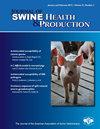Evaluating the impact of weaning weight and growth rate during the first week post weaning on overall nursery performance
IF 0.7
4区 农林科学
Q3 Agricultural and Biological Sciences
引用次数: 7
Abstract
Objective: Determine the effects of nursery pig weaning weight (WW) and first week postweaning growth rate (ADG7) on average daily gain (ADG), final weight, removals, and mortality under field conditions. Materials and methods: In this 42-day study, 1602 pigs (mean [SD] weight: 5.42 [0.9] kg) were weaned at 19 to 21 days of age. Four successive batches of weaned pigs were moved into the same nursery room. Within each batch, pigs were allotted by WW to have approximately one-third of each class (LightWW, MediumWW, and HeavyWW) in all pens. On day 7, pigs were individually weighed and designated according to their ADG7 into four classes within their batch: NegativeADG7, LowADG7, MediumADG7, and HighADG7. An equation was developed and validated to quantify the association between WW and ADG7 with ADG. Results: Weaning weight had no effect on ADG7 (P = .42), but increasing WW and ADG7 increased (P < .001) ADG and final weight at 42 days. Pig removal was reduced if pigs had heavy WW or gained weight in the first week after weaning (≤ 3.2%) compared to pigs that lost weight during the first week in the LightWW (20.9%) or MediumWW (10.3%) categories. Overall mortality was 1.1% with no effects of WW, ADG7, or its interaction (P > .54). The equation generated indicated that WW and ADG7 together had moderate accuracy (R² = 0.54; P < .001) to predict ADG. Implication: The WW and ADG7 are not correlated, but they affect and partially predict the overall nursery performance.评估断奶后第一周断奶体重和生长速度对整个苗圃性能的影响
目的:在田间条件下,测定断奶仔猪断奶体重(WW)和断奶后第一周生长率(ADG7)对平均日增重(ADG)、最终体重、去除率和死亡率的影响。材料和方法:在这项为期42天的研究中,1602头猪(平均[SD]体重:5.42[0.9]kg)在19至21天大时断奶。连续四批断奶的猪被转移到同一个育婴室。在每批猪中,WW将猪分配给所有围栏中每类猪的大约三分之一(LightWW、MediumWW和HeavyWW)。在第7天,对猪进行单独称重,并根据其ADG7将其指定为该批猪中的四类:阴性ADG7、低ADG7,中等ADG7和高ADG7。开发并验证了一个方程,以量化WW和ADG7与ADG之间的关联。结果:断奶体重对ADG7无影响(P=.42),但增加WW和ADG7使ADG和最终体重在42天时增加(P<.001)。与轻WW(20.9%)或中等WW(10.3%)类别中在第一周体重减轻的猪相比,如果猪在断奶后第一周出现重WW或体重增加(≤3.2%),则猪的去除率会降低。总死亡率为1.1%,没有WW、ADG7或其相互作用的影响(P>.54)。生成的方程表明WW和ADG7一起预测ADG具有中等准确性(R²=0.54;P<.001)。含义:WW和ADG7不相关,但它们影响并部分预测幼儿园的整体表现。
本文章由计算机程序翻译,如有差异,请以英文原文为准。
求助全文
约1分钟内获得全文
求助全文
来源期刊
CiteScore
1.80
自引率
0.00%
发文量
29
审稿时长
>36 weeks
期刊介绍:
The Journal of Swine Health & Production (JSHAP) is an open-access and peer-reviewed journal published by the American Association of Swine Veterinarians (AASV) since 1993. The aim of the journal is the timely publication of peer-reviewed papers with a scope that encompasses the many domains of applied swine health and production, including the diagnosis, treatment, management, prevention and eradication of swine diseases, welfare & behavior, nutrition, public health, epidemiology, food safety, biosecurity, pharmaceuticals, antimicrobial use and resistance, reproduction, growth, systems flow, economics, and facility design. The journal provides a platform for researchers, veterinary practitioners, academics, and students to share their work with an international audience. The journal publishes information that contains an applied and practical focus and presents scientific information that is accessible to the busy veterinary practitioner as well as to the research and academic community. Hence, manuscripts with an applied focus are considered for publication, and the journal publishes original research, brief communications, case reports/series, literature reviews, commentaries, diagnostic notes, production tools, and practice tips. All manuscripts submitted to the Journal of Swine Health & Production are peer-reviewed.

 求助内容:
求助内容: 应助结果提醒方式:
应助结果提醒方式:


